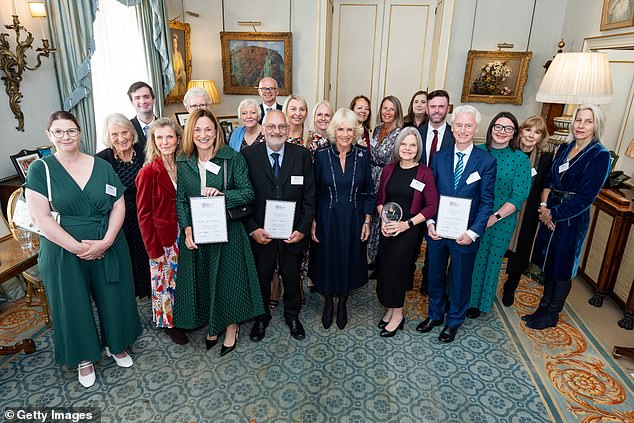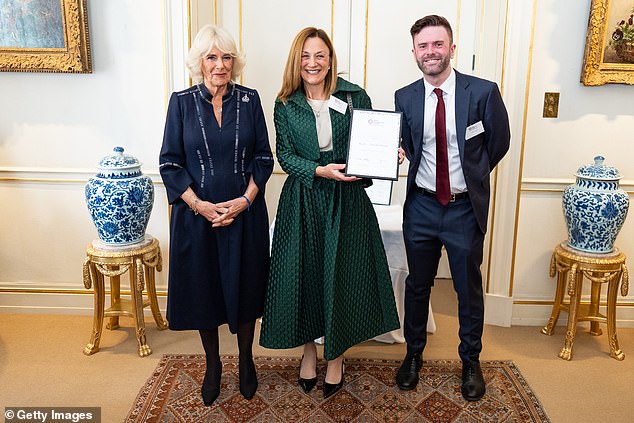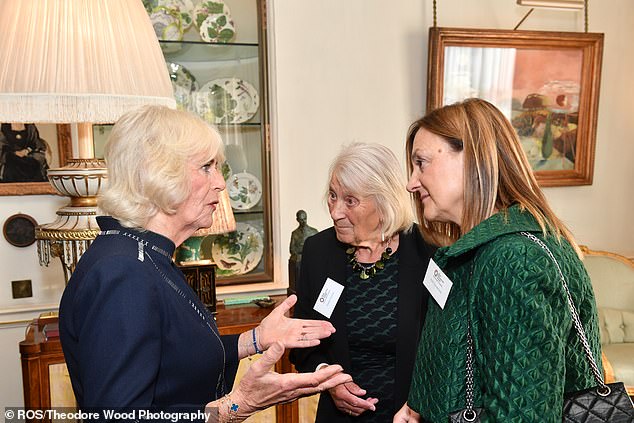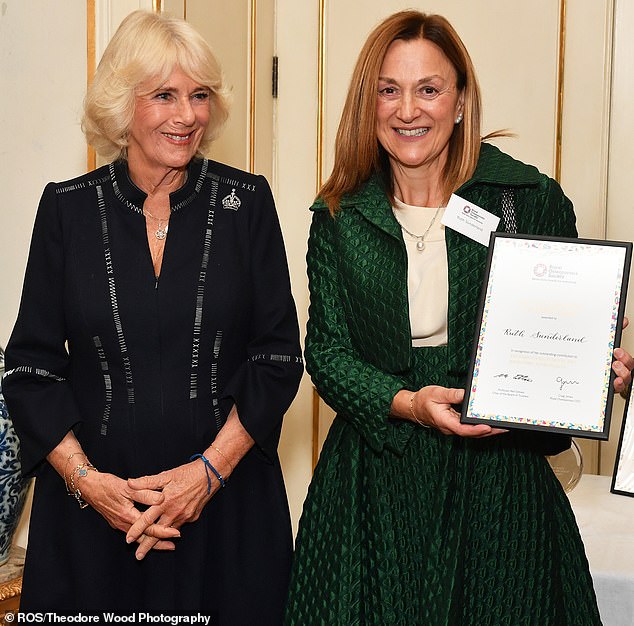“You’ve put osteoporosis on the map,” the queen said. “Can I just beg you to continue?” Camilla’s tribute to MoS’s Ruth Sunderland as she (and her mother) attend the royal reception for bone disease campaigners
Since being diagnosed with osteoporosis last fall, my life has taken surprising turns. But I didn’t expect this would lead to me – and my mother – meeting the Queen in the morning room of Clarence House.
I was invited because of my campaign in this newspaper to raise awareness of the deadly bone disease, in particular to help people get an early diagnosis by making Fracture Liaison Services available across the country.
At the reception, a certificate of appreciation was presented to me in the presence of Her Majesty. I felt a surge of pride as I stood next to her and as she expressed her “great gratitude” for the work this newspaper has done.
“It really put osteoporosis on the map,” she said. ‘Can I just beg you to keep going… it makes a huge difference to a lot of people who would otherwise go undiagnosed.’ At that moment I was shaking.
The run-up to the reception was nerve-wracking: with impeccable timing, I not only got a stye in my eye earlier in the week, but also an emergency visit to the dentist.
Mail on Sunday journalist Ruth Sunderland and her mother meet the Queen in the morning room of Clarence House

Queen Camilla with the winners of the inaugural Queen’s Award for Osteoporosis at Clarence House on October 3
Only with industrial amounts of make-up did I avoid looking like a farmer’s wife in a Breughel painting. I was shaking with anticipation when we arrived at the reception, an intimate affair with twenty guests. But mom was home right away.
She was not at all impressed and may have been in her back kitchen. Within moments she was chatting with actress Susan Hampshire, a celebrity ambassador for the Royal Osteoporosis Society.
It meant a lot to have my mother, Lyn Hunter, who is indomitably in her eighties, with me. Not least because I wanted to make things right. Over the weekend I suffered the fracture that led to my diagnosis a year ago. She had traveled from Teesside to visit me in London.
Instead of a lovely mother-daughter dinner, she sat with me in the emergency room at St. Thomas’ Hospital in London for five hours. As she said, she thought the days of taking her children to the hospital with broken bones were years ago.
Unfortunately, osteoporosis is often a mother-daughter affair. Mom has not been diagnosed, but having a parent with the disease is a risk factor.
The Queen, president of the Royal Osteoporosis Society, became involved because her mother and grandmother suffered terribly from the condition.
“There is still such a stigma” about osteoporosis, the Queen said in conversation with us.
This despite the fact that half of all women over 50 and one in five men suffer from it.
The Queen spoke movingly to us about her mother Rosalind Shand, who died of osteoporosis in 1994 at the age of 72.
“Nobody talked about it all those years ago,” the queen said, adding that signs of the disease, such as a “widow’s bump” or loss of height, were dismissed as old age at the time.
“My mother went to the doctor and he said to her, ‘You’re old, of course you’re going to have a bump,’” the queen said.

The Queen noted that Ruth’s work had ‘put osteoporosis on the map’

Queen Camilla, president of the Royal Osteoporosis Society, became involved because her mother and grandmother suffered terribly from the condition
‘We all felt so guilty because we thought she was making a fuss. We couldn’t believe someone was in so much pain – we didn’t know why she was screaming like that. She lost six to seven inches in height. She couldn’t do anything.’
The Queen asked Mom if she also had osteoporosis. “No, not that I know of,” Mom replied. “Have you ever been checked?” “No…” Mom admitted.
“Well, that’s the thing, no one has ever been checked in your generation,” the queen said. ‘Now younger people are being diagnosed. I suspect that would have been the case in your generation, but no one knew because no one checked.”
“At least you can do something about it,” the queen added, turning to me and asking me if I was receiving treatment.
When I mentioned that I was taking Evenity, a bone-building drug, she replied: ‘They (the treatments) are incredible. I’ve seen so many people completely rejuvenated.’ I said I wanted to stay healthy so I could take care of Mom. “It’s the other way around,” Mom protested.
Her Majesty spoke about the importance of scans, known as DEXAs, which identify osteoporosis.
“It’s so important for doctors to realize that when people go to their operating room with a broken bone, they should get a DEXA scan because this is the way to detect it,” she said.
My campaign in The Mail on Sunday was to achieve exactly that: rapid diagnosis and treatment after the first fracture.
If this happens, patients are likely to stop breaking bones and live well.
I want an end to a cruel postcode lottery that condemns millions of people to destroy their lives through avoidable breakups.
Fracture Liaison Services (FLS) are the gold standard. They pick up patients who arrive at the hospital with a broken bone and offer them a DEXA scan, which determines whether they have osteoporosis.

The Queen spoke movingly to us about her mother Rosalind Shand, who died of osteoporosis in 1994 at the age of 72
But FLS is only available in around half of England’s NHS trusts. It is offered across Scotland and Northern Ireland and full coverage is promised in Wales.
At the Labor conference, Health Secretary Wes Streeting pledged to deliver on a pledge to roll out the services across England by 2030.
But there are fears that the Treasury will reverse the £30 million cost, even if it is just a fraction of the burden the NHS has to bear in treating osteoporosis victims.
Craig Jones, chief executive of the Royal Osteoporosis Society, said The Mail on Sunday’s campaign had ‘shattered stereotypes’ and highlighted the fact that ‘younger people in the workplace, at the height of their careers, are suffering from this condition’.
Dr. Nicky Peel, consultant physician at the University of Sheffield, received the Queen’s Award for 30 years of outstanding work in the field of osteoporosis.
When the event ended, I was almost in tears, but Mom took it easy. “The queen is beautiful… and very nice shortbread,” she mused.
